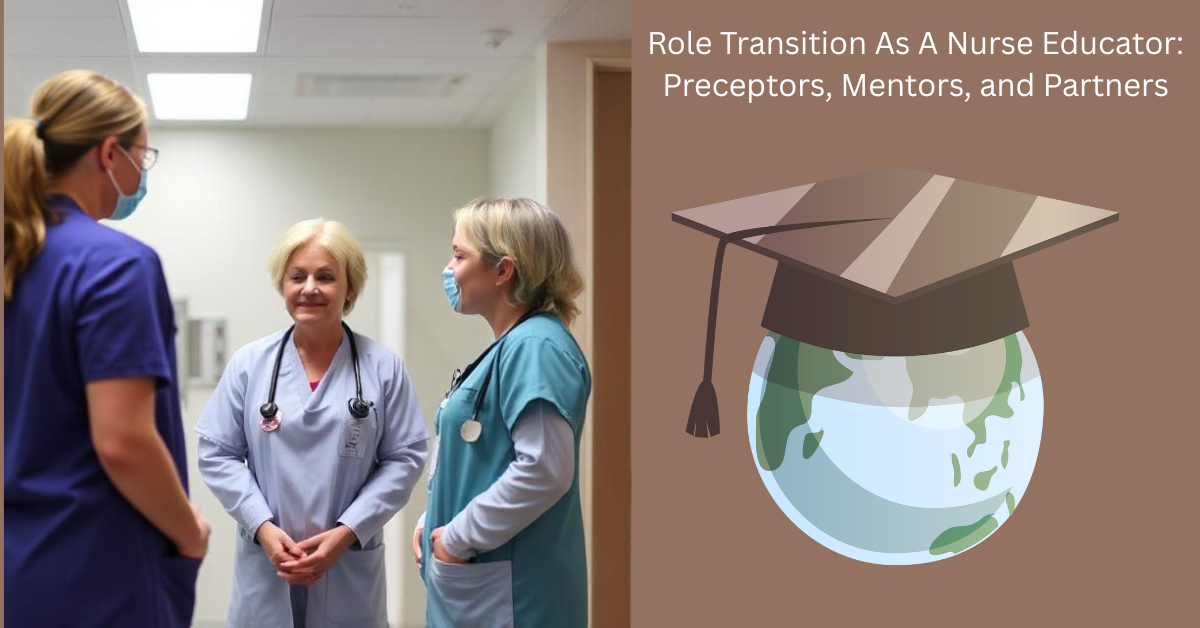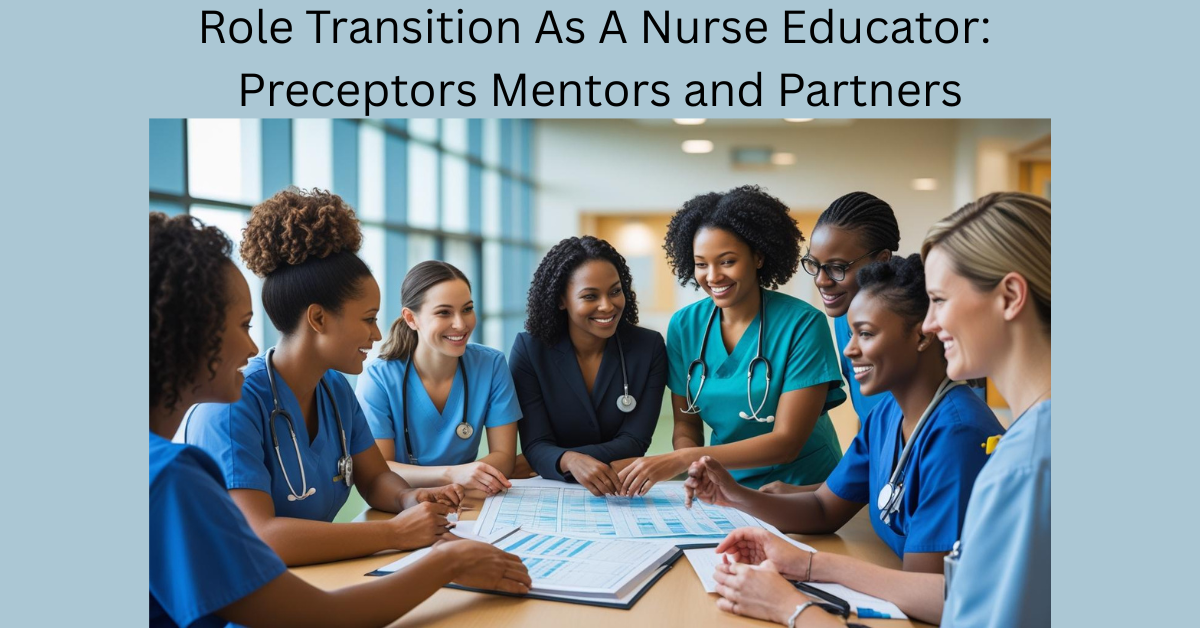In nursing education Role Transition As A Nurse Educator Preceptors, Mentors, and Partners in healthcare education for new students.
Preceptors Mentors and Partners: Role Transition As A Nurse Educator
Preceptors, Mentors, and Partners
Preceptors, mentors, and partners all differ but each serves a positive role in easing the transition from clinician to educator. A preceptor is a specialized tutor who gives practical training to the student. Use of preceptors to coach, role model, and evaluate in nursing education is becoming increasingly common. Preceptors are used at both the graduate and the undergraduate levels.
In addition, they have become popular in the practice setting where hospital nursing education departments have been pared down because of a lack of resources. The roles that a preceptor might be expected to assume include teacher, coach, facilitator, resource person, and evaluator. Preceptors ease the transition from clinician to educator by providing one-on-one instruction. In this environment, the learner is able to ask questions of his preceptor without the distraction of other student educators.
Preceptors provide the real-life experience of what it is like to be a nurse educator and how to deal with a variety of issues or problems that may arise. For example, in one preceptor-student educator dyad, the student educator described how much she learned from this one-on-one experience. She not only learned by watching the preceptor teach in a variety of environments; She also gained confidence through the positive comments, coaching, and opportunities for experience offered by her preceptor.
A mentor differs from a preceptor in that a mentor relationship may be more informal than a preceptor ship and usually is in place for a longer period of time. Vance (1982) defines a mentor as “someone who serves as a career role model and who actively advises, guides, and promotes another’s career and training.” Partnerships differ from mentor relationships in that partnerships are mutually beneficial to both partners.
Although precept ring and mentoring are usually confined to career development, partnerships can be beneficial in both professional and personal domains. Partnerships can be short-term, outcome-oriented, or long-term, such as professional growth–oriented and relationship- oriented partnerships (Heinrich et al., 2005).
Outcome-oriented partnerships are those that focus on a specific, predetermined outcome; they have a finite ending or goal that defines and limits the terms of the partnership. One example of an outcome-oriented partnership is working with a colleague to develop a presentation. Partnerships can be more open ended, such as those formed in professional growth–oriented partnerships and in relationship oriented partnerships.
Professional growth–oriented partnerships are evolving and ongoing in nature and include activities that foster personal professional growth. These partnerships might include activities such as designing innovative clinical education strategies, expanding the role of academic advisor, enhancing skills and knowledge surrounding learning styles, and working effectively with students with diverse abilities.
Relationship-oriented partnerships develop and exist for the sole purpose of building camaraderie. These types of partnership activities might include interdisciplinary partnerships with other faculty, networking with clinical/community partners, and building friendships and support systems. Partnerships ease the transition from clinician to educator mainly by providing support and expertise to the novice educator.
Finding a Preceptor
Often, the student’s advisor or professor may make suggestions based on connections with affiliated agencies. Choosing a preceptor solely based on proximity or ease of formulating a contract with the individual is not the best strategy. Graduate students should be advised to get to know leaders in their area of interest and make connections before the start of their practicum experience.
As much as it is important that the preceptor have the expertise and agree to precept the student, equally important are relational qualities and personal affiliation. Preceptors and graduate students should be able to work collaboratively in the experience. Communication should be facile and collegial. Defining roles and responsibilities in advance can help to set forth and maintain boundaries and expectations and thus alleviate stress.
Getting the Most From a Preceptorship
Students should enter the experience with an open mind and a willingness to learn from the expert. Be prepared with questions concerning boundaries and expectations for working with the preceptor’s patient population or student group. Develop a good rapport with the preceptor so any problems, questions, or issues can be addressed as they arise. Respect limits delineated by preceptors, such as the amount or type of feedback you will be allowed to give the nursing students.
For example, does the preceptor want the student educator to evaluate a nursing student’s performance? If so, under what circumstances would you use which evaluative tool or model? In what situations should the student educator avoid giving feedback? The preceptor-student educator relationship is complex in that the preceptor is serving in a dual role: that of teaching both nursing students and a student educator simultaneously. The student educator is in a dual role: that of both teacher and student.
Recognizing the complexity of the situation will help the student educator to respect role boundaries. In addition, student educators and preceptors need to build planning and evaluation time into the practicum. Planning will include activities such as developing objectives for the experience, timelines, and a workable schedule.
Evaluation should be ongoing throughout the practicum and should include both preceptor evaluation of the student educator performance and both parties’ evaluation of their relationship. Offering to help the preceptor can set the stage for a more fulfilling preceptor ship for both parties. What starts out as a preceptor-graduate student relationship may evolve into a partnership in which both parties learn and receive satisfaction.
From Preceptor to Mentor
A preceptor-graduate student relationship is usually intended for a predetermined length of time, with set objectives for the relationship and with expected roles for the relationship. Although a preceptor model may be one used in academia to provide one-on-one learning opportunities for the novice, it does not necessarily foster long-term relationships.
On the other hand, Vance and Olson (1998) have done extensive research on mentor relationships in nursing and found that mentored nurses are more likely to become leaders in their profession. Furthermore, 83% of influential nurses reported having one or more mentors. With the “graying” of nursing faculty, the future of nursing is at stake.
We need to recognize that the way to entice more nurses to become educators is by nurturing, supporting, and encouraging their pursuit of graduate education. What better way to do this than by participating in a mentoring relationship?
Specific help provided by mentors included career advice, guidance, promotion, professional role modeling, intellectual and scholarly stimulation, inspiration, idealism, teaching, advising, tutoring, and emotional support. Graduate nursing students should be on the lookout for a good mentor to support further career development. The prospective mentor may be a preceptor, an educator, or a peer.
Mentors to Partners
In today’s literature, we find that a mentoring relationship can be more of a partnership in which participants help and are helped by one another (Heinrich, Cote et al., 2003; Vance & Olson, 1998). This type of relationship has long-term benefits both for the individuals involved and the profession as a whole. You may ask, “Can every preceptor be a mentor/partner?”
The answer is maybe, maybe not; much depends on the shared commitment and affinity that both partners have for a mutually beneficial relationship. When mutual benefits are present in a mentorship (Vance & Olson, 1998), “mentoring assumes caring; a connecting with one another. “Connections of caring are sources of power and influence for both mentor/leader and protégé/rising star” (pp. 30–31).
One can see that both parties benefit from sharing one another’s perspective and expertise. It is time that nurse-educators stop trying to go it alone in nursing and reach out to others, to share gifts, talents, and insights.
A partnership relationship in which both participants reap the rewards from working with one another can help nurses individually and collectively be more satisfied in their professional and personal life (Eisen, 2001; Heinrich et al., 2005; Heinrich, Cote et al., 2003; Heinrich & Scherr, 1994). Mentoring partnerships created for the purpose of professional growth can help not only to ease the transition from clinician to educator, but also to achieve competence for the new nurse educator.
Cognitive Apprenticeship Specifically
Learning from an expert can best be accomplished by working closely, apprenticing, with the expert. Future nurse educators are not just apprenticing in the skill of teaching, they are also learning the thinking, reasoning, and critical thinking necessary. Cognitive apprenticeship pro vides a framework from which to plan teaching-learning experiences. Cognitive apprenticeship is a framework in which learning is depicted as a social process occurring within communities of practice (Lave & Wenger, 1991).
Participation begins in the periphery of the occupation being learned, and through novice-expert relationships, the learner becomes increasingly more involved in complex, higher-order issues. “Cognitive apprenticeship derives its power from knowledgeable, proficient people showing learners how to do something and stating aloud what they are thinking while doing the activity” (Brandt, Farmer, & Buckmaster, 1993, p. 75). In the cognitive apprenticeship process, learners work with a master (expert) who teaches by the methodologies.
Preceptors and Cognitive Apprenticeship
The cognitive apprenticeship framework described earlier can be used by preceptors, mentors and, in some cases, partners. Cognitive apprenticeship has been shown to facilitate learning from experience. A preceptor or mentor can use cognitive apprenticeship strategies. Strategies such as modeling, coaching, scaffolding support, promoting reflection, promoting articulation, and providing a variety of experiences, can help teach future nursing educators.
Consider how cognitive apprentice ship can be used in graduate education within the preceptorship experience. Preceptors, those specialized tutors who give practical training to student educators, are an integral part of graduate education. Both the preceptor and learner have a role in the apprentice ship process. The preceptor serves as a role model for the student educator in that he has expertise in the field.
Preceptors model their expertise when they help the student educator develop a teaching-learning plan that includes learning objectives, time frames, and learning activities. During the course of the preceptor-student relationship, the preceptor will share stories from her practice that exemplify practical knowledge, as well as values and attitudes essential in nursing education. Preceptors will coach their student educators as they take on more responsibility for teaching.
In the coaching role, the preceptor provides encouragement and support as the student tests the waters of being a nurse educator. The preceptor encourages the student to be as self-directed as possible in taking on the role of nursing educator. Learning is an active process that involves individual construction of knowledge based on one’s earlier experience.
Coaching and providing scaffolded support are key strategies where the amount and intensity of support is gradually diminished as the student takes on more responsibility and accountability. Although the preceptor’s presence is felt, reliance on the preceptor’s knowledge and experience decreases over time. The preceptor should be available to answer questions as needed, but must recognize the value in self-directed learning and push the student to become more independent in their learning over time.
Student educators should be encouraged to seek new ways of looking at experiences, ever questioning, reflecting on experience, and refining knowledge construction. Coaching and scaffolding provide the challenge and support necessary for students to consider their practice and evaluate their performance continuously as they transition from practitioner to educator. Reflection, articulation, and experience are strategies that the graduate student should use in the teaching-learning process.
The graduate student should analyze and determine goals for the preceptor experience. Students should be encouraged to reflect on their experience in order to optimize learning. Reflection-in-action entails thinking during practice, and reflection-on-action (Schon, 1991) involves thinking back on the practice session and analyzing decisions/events that occurred.
Both enhance learning and aid in the process of evaluation. While graduate students are being precepted, they should write a journal for each day of their experience; they should write about the experience and connect what they have seen or done during their practicum with literature that they are reading for the course. Students are encouraged to question any problems/concerns they encounter during their anticipated experience. They can articulate this reflection either in writing or through discourse.
Much research supports the importance of thinking about one’s thoughts and responses in a situation to maximize learning from experience (Mattingly, 1991; Schon, 1991; Sheckley, 1997). Reflection on experience and articulation of an experience promote critical analysis and expand learning opportunities.
For example, when a student educator reflects on a nursing student performing an injection for the first time and describes the performance in her journal, she realizes that only one domain of learning should be focused on at a time in order to optimize skill development. The student educator who does not reflect and articulate theory to practice connections, in this instance, domains of learning, would not make this connection.
Consequences of a lack of reflection and critical analysis are that the future educator may ask cognitive questions while a nursing student is performing a psychomotor skill, thus interfering with skill development. Graduate student responsibilities therefore include elaborating and prioritizing specific learning to meet needs, meeting with the preceptor to develop a tentative schedule of activities to meet learning objectives, and seeking feedback from the preceptor on an ongoing basis. Discussing and evaluating the boundaries and expectations of the preceptor relationship uses both reflection and articulation to enhance learning from experience.
Summary
Like learning, role transition from nurse to nurse educator can at times be a painful process. This chapter has offered some suggestions to facilitate the transition by developing partnerships and using cognitive apprenticeship as a framework to ease the transition. The cognitive apprenticeship model has been used in studies of developing expertise and learning from experience.
It is particularly applicable to professional development as it incorporates reflective strategies that are essential for competent practice. Reflective practice can be enhanced by bouncing ideas off of a partner. A reciprocal learning relationship helps both partners to grow, as ideas, thoughts, and problems are analyzed from multiple perspectives.
Going it alone is an antiquated belief that has perpetuated the current faculty shortage. It is time that nurse educators develop a pass-it-on mentality and work together to invite colleagues to join them in educating the next generation of nurses. Working together, learning from one another, and developing power with relationships rather than power over student-teacher relationships will not only ease the transition to nurse educator but will invite others to join the league of nurse educators.
Read More:
https://nurseseducator.com/high-fidelity-simulation-use-in-nursing-education/
First NCLEX Exam Center In Pakistan From Lahore (Mall of Lahore) to the Global Nursing
Categories of Journals: W, X, Y and Z Category Journal In Nursing Education
AI in Healthcare Content Creation: A Double-Edged Sword and Scary
Social Links:
https://www.facebook.com/nurseseducator/
https://www.instagram.com/nurseseducator/





I simply wanted to thank you so much yet again. I am not sure the things that I could possibly have done without these thoughts documented by you on that subject matter. This was a difficult issue in my circumstances, but spending time with the very well-written style you resolved it made me to jump over delight. I’m just grateful for this assistance and thus pray you comprehend what a powerful job your are getting into educating many others through your web page. I know that you’ve never come across any of us.
This web page is mostly a walk-via for all the data you needed about this and didn’t know who to ask. Glimpse here, and also you’ll positively discover it.